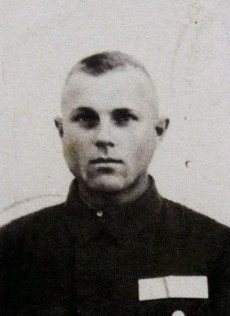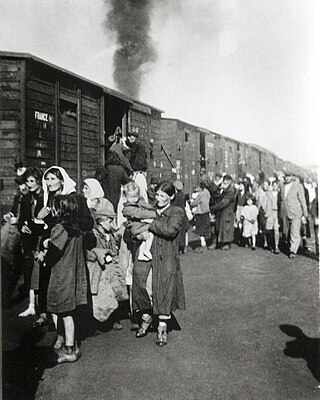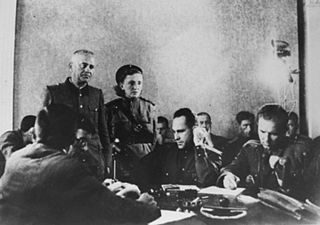
Treblinka was the second-deadliest extermination camp to be built and operated by Nazi Germany in occupied Poland during World War II. It was in a forest north-east of Warsaw, 4 km (2.5 mi) south of the village of Treblinka in what is now the Masovian Voivodeship. The camp operated between 23 July 1942 and 19 October 1943 as part of Operation Reinhard, the deadliest phase of the Final Solution. During this time, it is estimated that between 700,000 and 900,000 Jews were murdered in its gas chambers, along with 2,000 Romani people. More Jews were murdered at Treblinka than at any other Nazi extermination camp apart from Auschwitz-Birkenau.

John Demjanjuk was a Ukrainian-American who served as a Trawniki man and Nazi camp guard at Sobibor extermination camp, Majdanek, and Flossenbürg. Demjanjuk became the center of global media attention in the 1980s, when he was tried and convicted in Israel after being misidentified as "Ivan the Terrible", a notoriously cruel watchman at Treblinka extermination camp. In 1993 the verdict was overturned. Shortly before his death, he was tried and convicted in the Federal Republic of Germany as an accessory to the 28,060 murders that occurred during his service at Sobibor.

Operation Reinhard or Operation Reinhardt was the codename of the secret German plan in World War II to exterminate Polish Jews in the General Government district of German-occupied Poland. This deadliest phase of the Holocaust was marked by the introduction of extermination camps. The operation proceeded from March 1942 to November 1943; about 1.47 million or more Jews were murdered in just 100 days from late July to early November 1942, a rate which is approximately 83% higher than the commonly suggested figure for the kill rate in the Rwandan genocide. In the time frame of July to October 1942, the overall death toll, including all killings of Jews and not just Operation Reinhard, amounted to two million killed in those four months alone. It was the single fastest rate of genocidal killing in history.
The Office of Special Investigations (OSI) of the U.S Justice Department was created in 1979 to identify and expel, from the United States, those who assisted Nazis in persecuting "any person because of race, religion, national origin, or political opinion." This involved gathering, verifying, and presenting in court eyewitness and documentary evidence of decades-old crimes. The evidence was incomplete and scattered around the world. Much of it was then in Eastern Europe, behind the Iron Curtain. Nonetheless, the OSI investigated 1,700 persons suspected of being involved in Nazi war crimes. Over 300 have been prosecuted with at least 100 stripped of their U.S. citizenship and 70 deported, the most recent in 2021. Others have left voluntarily, fled, or have been blocked from entering the United States.

The Holocaust—the murder of about six million Jews by Nazi Germany from 1941 to 1945—is the most-documented genocide in history. Although there is no single document which lists the names of all Jewish victims of Nazi persecution, there is conclusive evidence that about six million Jews were murdered. There is also conclusive evidence that Jews were gassed at Auschwitz-Birkenau, the Operation Reinhard extermination camps, and in gas vans, and that there was a systematic plan by the Nazi leadership to murder them.

The Dachau trials, also known as the Dachau Military Tribunal, handled the prosecution of almost every war criminal captured in the U.S. military zones in Allied-occupied Germany and in Allied-occupied Austria, and the prosecutions of military personnel and civilian persons who committed war crimes against the American military and American citizens. The war-crime trials were held within the compound of the former Dachau concentration camp by military tribunals authorized by the Judge Advocate General of the U.S. Third Army.
Operation Last Chance was launched July 2002 by the Simon Wiesenthal Center with its mission statement being to track down ex-Nazis still in hiding. Most of them were nearing the end of their lifetimes, hence the operation's name. Efraim Zuroff is director of the Wiesenthal Center in Jerusalem who serves as the Israeli liaison as well as overseer of this project, the focus of which is an investigation, prosecution, and conviction of the last remaining Nazi war criminals and collaborators. Many have obtained citizenship in Canada and the United States under false pretenses; usually by misrepresentation, omission, or falsification of their criminal past, specifically, war crimes which rose to the level of crimes against humanity.
Karl Linnas was an Estonian who was sentenced to death during the Holocaust trials in Soviet Estonia in 1961–1962. He was later deported from the United States to the Soviet Union in 1987.

Sonderaktion1005, also called Aktion1005 or Enterdungsaktion, was a top-secret Nazi operation conducted from June 1942 to late 1944. The goal of the project was to hide or destroy any evidence of the mass murder that had taken place under Operation Reinhard, the attempted extermination of all Jews in the General Government occupied zone of Poland. Groups of Sonderkommando prisoners, officially called Leichenkommandos, were forced to exhume mass graves and burn the bodies; inmates were often put in chains to prevent them from escaping.
Frank Walus (1922-1994) was born in Germany of Polish parents and emigrated to the United States in 1963. He worked in a factory in the Chicago area and became a US citizen in 1970. In 1973 he was accused of having been a Nazi who beat and killed Jews in Poland during World War II. Prosecution was initiated by the US Immigration and Naturalization Service (INS) in 1977. He was convicted based upon questionable testimony in a bench trial before a judge who appeared visibly hostile to the defense. An appeals court vacated the verdict and ordered a new trial before a different judge. By this time, the new Office of Special Investigations (OSI) had been established in the US Department of Justice. After conducting a lengthy and exhaustive investigation of witnesses and documents, OSI concluded that it "could not responsibly go forward with a new trial." OSI dropped the charges, expressed regret that they had ever been filed, and partially reimbursed Walus for his expenses.

Feodor Fedorenko or Fyodor Federenko was a Soviet Nazi collaborator and war criminal who served at Treblinka extermination camp in German occupied Poland during World War II. As a former Soviet citizen admitted to the United States under a DPA visa (1949), Fedorenko became a naturalized U.S. citizen in 1970. His prior Nazi collaboration was discovered in 1977, leading to his denaturalization in 1981. Subsequently, he was deported to the USSR and sentenced to death for treason and participating in the Holocaust. Fedorenko was executed in 1987.
Boļeslavs Maikovskis was a Latvian Nazi collaborator who served as chief of police for the second precinct of Rēzekne while the Germans occupied Latvia in World War II. After the war Maikovskis went to Austria before reaching the United States in 1951 where he served on a subcommittee of the Committee to Re-elect the President during Richard M. Nixon's 1972 campaign.

The two Treblinka trials concerning the Treblinka extermination camp personnel began in 1964. Held at Düsseldorf in West Germany, they were the two judicial trials in a series of similar war crime trials held during the early 1960s, such as the Jerusalem Adolf Eichmann trial (1961) and the Frankfurt Auschwitz Trials (1963–65), as a result of which the general public came to realize the extent of the crimes that some two decades earlier had been perpetrated in occupied Poland by German bureaucrats and their willing executioners. In the subsequent years, separate trials dealt with personnel of the Bełżec (1963–65), Sobibor (1966), and Majdanek (1975–81) extermination camps.
Anton Geiser was a Yugoslav-born member of the SS-Totenkopfverbände during World War II, who served as a guard at both the Sachsenhausen and Buchenwald concentration camps. In 1956 he moved to the United States, settling in Sharon, Pennsylvania, where he had family. In 1962 he became a naturalized American citizen. In 2006 he was stripped of his citizenship on the grounds that it would not have been granted had the full details of his role in the German military been known; in 2010 a US judge ordered him deported to Austria, the country from which he had immigrated. He died in Pittsburgh on December 21, 2012, while still battling his deportation.
Allan A. Ryan Jr. was an American attorney, author and a law professor at Harvard University, where he taught from 1985 until his death. He is best known for his work as a Justice Department lawyer who in the early 1980s identified and prosecuted dozens of Nazi collaborators living in the United States, earning him a reputation as America's foremost Nazi hunter.

The Belzec trial in the mid-1960s was a war crimes trial of eight former SS members of Bełżec extermination camp. The trial was held at the 1st Munich District Court and should be seen in the context of the Sobibor trial, which followed the Belzec trial, because five of the defendants were accused in both trials. In addition, the Belzec and Sobibor trials, along with the Treblinka trials, form a body of evidence of the crimes of mass extermination as part of the so-called Action Reinhardt programme - the killing of over two million Jews and 50,000 Roma and Sinti. These trials are directly related to the mass murder of 100,000 people in the official Nazi Euthanasia programme known after the war as Action T4, as many of the security guards worked in the euthanasia centres before transferring to the extermination camps. The first Euthanasia trials were carried out shortly after the war.

The Majdanek trials were a series of consecutive war-crime trials held in Poland and in Germany during and after World War II, constituting the overall longest Nazi war crimes trial in history spanning over 30 years. The first judicial trial of Majdanek extermination camp officials took place from November 27, 1944, to December 2, 1944, in Lublin, Poland. The last one, held at the District Court of Düsseldorf began on November 26, 1975, and concluded on June 30, 1981. It was West Germany's longest and most expensive trial, lasting 474 sessions.

During World War II, Trawniki men were Central and Eastern European Nazi collaborators, consisting of either volunteers or recruits from prisoner-of-war camps set up by Nazi Germany for Soviet Red Army soldiers captured in the border regions during Operation Barbarossa launched in June 1941. Thousands of these volunteers served in the General Government territory of German-occupied Poland until the end of World War II. Trawnikis belonged to a category of Hiwis, Nazi auxiliary forces recruited from native subjects serving in various jobs such as concentration camp guards.
Samuel Rajzman (1902–1979) was a Polish Holocaust survivor. After the war he emigrated to France and then to Canada. He was one of the two Polish witnesses at the Nuremberg Trials. He was also a witness at the Treblinka trials and during the process of Fiodor Fedorenko.











